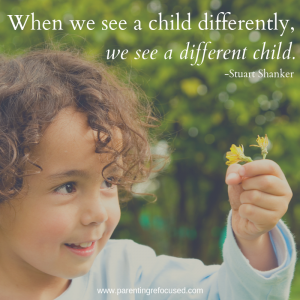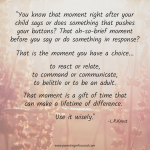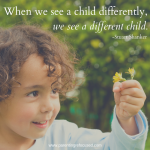Sometimes we get so caught up in managing challenging behaviours that we forget about all the other parts of the child who’s behind them- his development, his strengths, his feelings.. When we take a step back and refocus, we see a different child.
Take the above picture, for example:
Did the child here just make a mess in the garden digging up a bunch of ugly weeds again, or did he lovingly pick two beautiful flowers for someone special?
Whichever perspective we choose to take will impact our response, which then impacts his response.. and so on.
Behaviour is a form of communication, and it’s used to meet a need. If we respond only based on the behaviour, it may continue or even worsen due to the unmet need. If we can identify what need our child is trying to meet, we can help him meet it in a more appropriate way.
A toddler who takes a toy from another child without asking usually just sees this as an easy way to get the toy, and doesn’t even connect that his action is why the other child is crying. If he’s done this repeatedly and he keeps getting to play with the toy, is he “bad” or did he simply find a way to meet his need? We can choose either perspective, but if we’d like to change this behaviour it’s more helpful to choose the latter view.
Putting It Into Practice
If your young child has started pulling or climbing on you while you’re talking with someone and you’ve already asked her to stop with no response, you may initially see a rude child who’s simply being defiant. When we respond right away with this mindset we often end up yelling or threatening. Sometimes this will stop the behaviour, but may lead to other concerns later. Or it can backfire and make the situation worse.
If you choose to stop and refocus first instead, you may see a different child- one who is tired, hungry, or restless, who’s trying to express this through her behaviour. Responding based on that is more likely to include compassion and addressing her underlying needs.
If she’s too emotional to respond rationally, you may need to connect more with her first, like in this post. Otherwise, you could try using a format like this:
- What behaviour is happening
- What she can say and do instead to get her need met
- How and when you will help her meet it, if necessary
“You’re climbing on me and I’ve asked you to stop. If you want my attention, you can say ‘Excuse me’, and then you can tell me what you need. (Wait while she does this.) Thank you for letting me know how you feel. I’m sorry that it’s taken longer than I expected. You were waiting so well for me to finish talking so we could go home, but now it’s feeling extra difficult for you to keep waiting. I need 2 more minutes to finish and then we’re going. You can run to the end of the field and back or you can sit here nicely by me, which would you prefer?”
(Sometimes we really have pushed it too far though- such as when it’s past time to eat or sleep- and we may need to continue our adult conversation later.)**
It can be difficult to adjust to this refocusing at first (for us and for our kids), so we need to give ourselves a lot of grace. Like every new skill, it takes practice. The more we try, the more we’ll learn and improve.
And then we’ll fail, and try again.. and fail, and try again.. Just like our kids do.
Is there a challenging behaviour you’re dealing with that might be improved by seeing your child differently? Feel free to leave a comment, because it helps to share! Not only for the person sharing, but for everyone else going through the same problem who isn’t quite ready to.
**All examples are included as general guidelines- they’re not meant to be used as scripts. You know your child and the situation best, and can work on applying the parts you find helpful to create your own personal response.








Comments